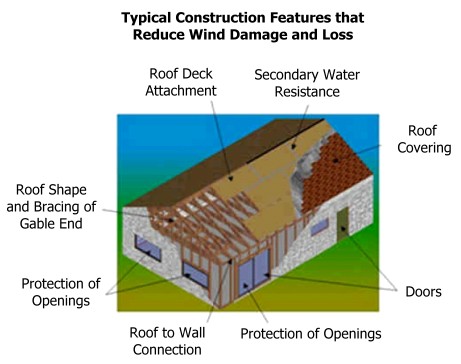Notice of Premium Discounts for Hurricane Loss Mitigation Information contained in your homeowners insurance policy explains the premium discounts, the discount amounts, and the requirement to have a Uniform Mitigation Verification Inspection performed by a Professional Licensed Inspection Company. Disaster Smart’s Wind Mitigation Inspections are accepted by all Florida Insurance Companies.
All residential structures including single family homes, condos, townhomes or apartments qualify for premium credits. The windstorm premium discounts are based on your home or residence having one or more of the following wind resistant features.

If your roof has been replaced after March 1, 2002, it should have a roof covering that is tested to resist uplift from 110 MPH winds qualifying for a premium discount. In order to qualify your roof covering you will need proof of the year of replacement AND documentation of the roofing manufacturer and model, examples of proof are;
LEFT and LEFT CENTER: are examples of an 8 Penny (8d) Ring Shank Nail and 8Penny (8d) Smooth Nail, if these are used and spaced a maximum of 6-12 inches on center it qualifies for a credit (Superior or Intermediate). RIGHT CENTER and RIGHT: Staples and 6 Penny (6d) Nails, these are the weakest form of attachment and do not qualify for any credit.
LEFT: Typical Toe-Nailed Rafters on older homes. LEFT CENTER: Metal Clip CENTER: Double Sided Metal Clip. RIGHT CENTER and RIGHT: Strap or Single Wrap. All but the first photo of the Toe-Nail qualify for credits. There are additional requirements for straps and clips, they must have at least three nails, they have to be free of severe corrosion and they must be properly installed. If your connectors look like the ones below they will not meet the requirements to qualify for a credit
LEFT and CENTER LEFT: Improperly installed with slack in them promoting premature failure. RIGHT CENTER Severe Corrosion the galvanic coasting has rusted away and the metal is loosing strength. RIGHT: Improper installation AND only has 2 nails.
If your home has a Hip roof the inspection will qualify the Roof Geometry for a premium discount.
LEFT: This is a full Hip Roof and qualified for discounts. CENTER: This is a Dutch HIP roof and does not qualify for discounts because the non-hip features are more than 10% or the total perimeter. RIGHT: This is a Gable roof and does not qualify for discounts.
SWR (also called Sealed Roof Deck or SRD) is a method or providing additional protection from water damage from typical roof covering failures common in wind and hail storms. Sealing the roof deck requires using either a continuous self-adhering roll or 4-6 inch wide self-adhering roof deck tape.
LEFT: SprayFoam Hurricane Adhesive is one form of SWR that is applied inside the attic to the underside of the decking at all trusses and all plywood joints, this should not be confused with spray foam insulation products; insulation alone does not qualify. CENTER: By far the most cost effective type of SWR is applied during a re-roof, 4-6 inch wide strips of self adhering tape are applied to all plywood/OSB joints before the roofing underlayment is applied. RIGHT: Continuous self adhering cap sheets are typically used prior to application of tile or metal roofs. To qualify for the discount, documentation of the existence of a qualified SWR is required through photos, or a roofing contractor’s affidavit.
If your home was permitted after March 1, 2002 (proof required) or built in 2004 or later then you already have most of the qualified features, the inspection will qualify and additional features that you may not be getting a credit for. These include Roof Geometry, Secondary Water Resistance, and Opening Protection. The reason these are not automatic credits is because they are not required by the building code everywhere and Code enforcement varies from county to county, especially between 2002 and 2008.
If you have added shutters or impact glass windows, doors, and ALL Openings including doors, windows, garage doors, sliding doors, skylights, glass block, etc., and the following is true you qualify for a premium discount.
Copyright 2023© - Disaster Smart - All Rights Reserved®.